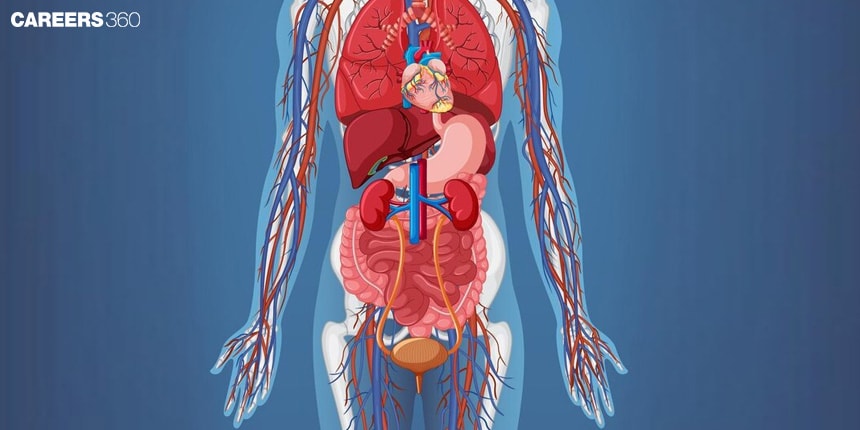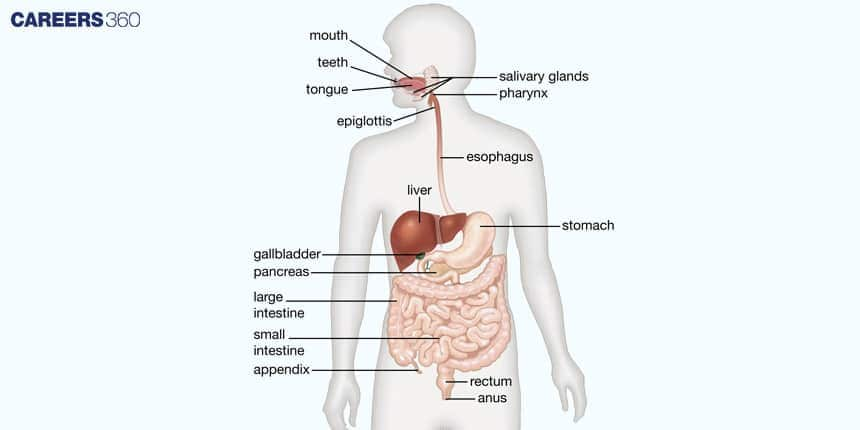Alimentary Canal - Anatomy, Structure, Functions, Types
The alimentary canal is often referred to as the digestive tract. It is long, tube-like with no apparent lumen. It extends from the mouth to the anus, where digestion, absorption, and excretion occur. This canal has different parts and each one of them has its importance in the entire process of digestion. This topic of Biology is included as a core part of the chapter Digestion and Absorption.
NEET 2025: Mock Test Series | Syllabus | High Scoring Topics | PYQs
NEET Important PYQ's Subject wise: Physics | Chemistry | Biology
New: Meet Careers360 B.Tech/NEET Experts in your City | Book your Seat now
- What is the Alimentary Canal?
- Anatomy of the Alimentary Canal
- Parts of the Alimentary Canal
- Layers of the Alimentary Canal

What is the Alimentary Canal?
The alimentary canal is an extended, continuous, hollow tube running from the mouth to the anus. It performs the digestion of food and absorption of nutrients, with the elimination of waste. The complex system involves multiple organs and processes working to ensure that the body receives proper nourishment for energy, growth, and repair. The anatomy and functions of the alimentary canal are the keys to understanding how our bodies process the food we eat.
Also Read:
Anatomy of the Alimentary Canal
The alimentary canal is about a 9-meter-long, continuous muscular tube extending from mouth to anus. It represents an important part of the digestive process, consisting of many organs that are specially differentiated regions of this canal, working in a coordinated manner on food digestion, absorbing the released nutrients, and finally, the elimination of the remaining waste.
Those sections are the mouth, pharynx, oesophagus, stomach, small intestine, large intestine, rectum, and anus. All these sections take part in digestion and nutrient absorption to meet the organism's needs for proper functioning. An adult alimentary canal is approximately 9 meters in length.
Alimentary Canal

Parts of the Alimentary Canal
Each part of the alimentary canal has different structures and carries out different functions required in digestion.
Mouth
Teeth: Aids in mechanical digestion by grinding.
Tongue: Aids in moving food around with its movement and is covered with taste buds.
Salivary Glands: Secrete saliva that contains an enzyme amylase.
Functions
Ingestion: Taking food.
Mastication: The mechanical breaking of food by chewing.
Enzymatic Breakdown: Initial digestion of carbohydrates by salivary amylase.
Pharynx
Oropharynx: The passageway for food.
Nasopharynx: Part of the respiratory pathway.
Laryngopharynx: It leads to the oesophagus.
Function
Pathway for Food and Air: The food passes into the oesophagus and the air into the larynx.
Oesophagus
The lining of the muscular tube is of stratified, squamous epithelium.
The Sphincters: There is an upper oesophagal sphincter and a lower oesophagal sphincter.
Function
Peristalsis: Wave contractions of the muscles which propel the food towards the stomach.
Transport: Food from the pharynx into the stomach.
Stomach
Regions: Fundus, body, antrum, and pylorus
Gastric Glands: Secrete hydrochloric acid and pepsinogen
Function
Storage: Stores swallowed food temporarily.
Mixing: Food is churned with gastric juices and changed into chyme.
Acid Secretion: Hydrochloric acid activates the pepsinogen into pepsin.
Initial Protein Digestion: Pepsin breaks down protein into peptides.
Small Intestine
Segments: Duodenum, jejunum, ileum.
Villi and Microvilli: Increase surface area to absorb.
Functions
Absorption of Nutrients: Primary area for the absorption of nutrients into the bloodstream.
Digestion: Further break down the carbohydrates, proteins, and fats.
Surface area enhancement: The villi and microvilli maximise the efficiency of absorption.
Large Intestine
Segments: Cecum, colon , rectum.
Houses some friendly bacteria.
Function
Water Absorption: Indigestible food has water and electrolytes reabsorbed here.
Formation of Feces: The residual waste is compacted into faeces.
Vitamin Production: Some vitamins, such as vitamin K, are produced by bacteria.
Rectum and Anus
Rectal Walls: There are stretch receptors that send signals that it is time to defecate.
Anal Sphincters: There are internal ( involuntary ) and external ( voluntary ) sphincters.
Function
Storage: This is the final storage area for faeces until it is eliminated.
Defecation: Controls the expulsion of faeces from the body.
Layers of the Alimentary Canal
The alimentary tract's walls share a fundamentally consistent basic structure across the whole tract. To achieve the necessary functionality, specific portions of an alimentary canal may, however, differ physically.
The human alimentary canal tract is further divided into four layers from inside to outside respectively :
Mucosa (Innermost layer)
Sub Mucosa
Muscularis
Serosa (Outermost layer)
Mucosa
The mucosal, or mucous membrane layer, is the innermost wall lining the alimentary canal lumen. Three more layers are separated from the mucous membrane Epithelium, Lamina propria which is a loose connective tissue layer, and Muscularis mucosa- a smooth muscle layer.
Different portions of the alimentary canal have differences in their fundamental structure depending on their activity and role.
The mucosal membrane in the mouth and the anus is composed of stratified squamous tissue to protect the alimentary canal from abrasion, while the stomach and intestine have thin columnar cells in the epithelium to allow for nutrient absorption.
The epithelium of the small intestine is folded into finger-like extensions to create a high surface area for nutrient absorption.
In the mucus layer, epithelial tissue like goblet cells release mucus and specific digestive enzymes.
Submucosa
The mucosal membrane is encircled by an uneven, thick layer of connective tissue that houses lymphatic vessels, nerve terminals, and blood vessels.
The submucosal layer is made up of fibroblasts, collagen and an acellular matrix. This layer also contains certain glands, such as Brunner glands.
The submucosa of the duodenum is the site of Brunner's glands.
They release an alkaline fluid that contains mucin that protects the mucosa from the stomach contents' acidic influx into the duodenum.
Muscularis is layer of smooth muscle is in charge of the peristaltic movement and segmental contractions that carry food along the alimentary canal.
Its longitudinal muscle layer as well as the inner circular layer are the two layers in which these smooth muscles are organized.
Between the two smooth muscle layers is a small layer of connective tissue.
The plexus Myenteric plexus or also called as Aurbach plexus.
It is a type of vascular connective tissue, that houses the myenteric nerve plexus.
The motility of the digestive tract is controlled by the myenteric nerve plexus.
Serosa
The organs located in the peritoneal cavity behind the diaphragm are covered by the serosa, a loose layer of connective tissue.
This layer, which is made up of secretory epithelial cells, lessens friction brought on by muscle activity.
Also Read:
Recommended Video on Alimentary Canal
Frequently Asked Questions (FAQs)
The alimentary canal is a continuous tube from the mouth to the anus concerned especially with digestive and absorptive processes of food and elimination of waste products.
The seven components are
The mouth,
pharynx (throat)
Oesophagus
Stomach
small intestine
large intestine
rectum
anus
The primary function of the alimentary canal is to digest food into absorbable components and transfer those components to the body's other organs.
The small intestine has villi and microvilli that increase the surface area for efficient digestion and absorption of nutrients.
Some common problems or disorders are GERD, peptic ulcers, Irritable Bowel Syndrome and Crohn's disease.
The stomach is mainly an organ of storage, blending food with the digestive juices and manufacturing acid and enzymes which break down food, starting the digestion of the proteins.
Also Read
30 Nov'24 03:25 PM
26 Nov'24 05:38 PM
25 Nov'24 06:43 PM
25 Nov'24 05:45 PM
25 Nov'24 04:48 PM
25 Nov'24 03:52 PM
23 Nov'24 04:30 PM
23 Nov'24 10:03 AM

